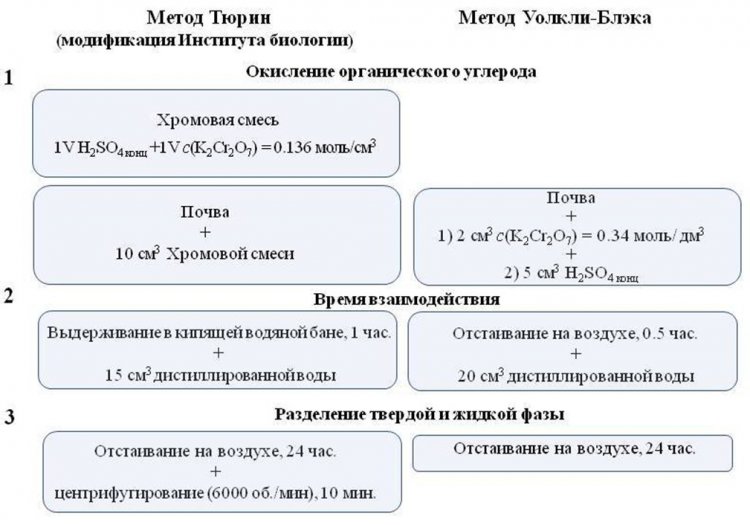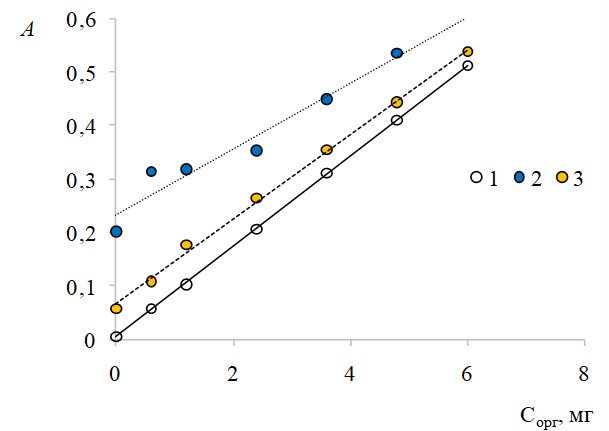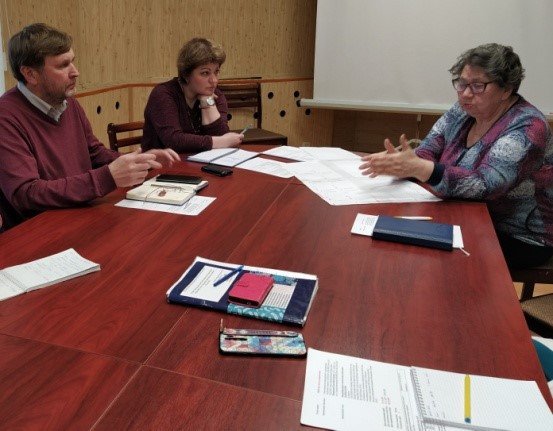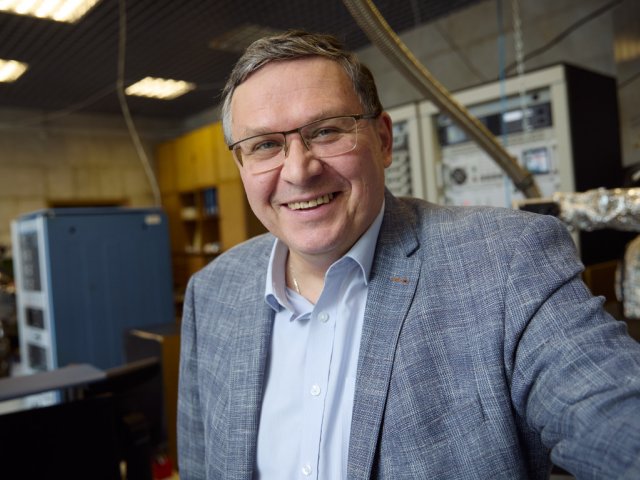The scientists of Biology Institute at the Komi Research Center of Ural Subdivision of RAS presented their experience of harmonizing the approaches to soil analysis sharing the results of project on developing methods of measuring soil organic matter content within the framework of work in GLOSOLAN (Global Soil Laboratory Network). It is contribution to integration of data accumulated by world’s soil analysts over the historical period. The unification of measuring methods is helpful in implementing global initiatives including sustainable soil management, mapping, food security, as well as adaptation to climatic change and mitigation of its consequences
For accounting and describing soil resources, designing the farming landscape systems and forecasting the behavior of soil systems being exposed to anthropogenic impact, it is necessary to pool information collected by different groups, regions, countries and continents. The development of harmonized standards and search for correction factors helps make an inventory of soil-geographical data. The accomplishment of such tasks allows for creating shared data arrays in streamlined form, which eventually assists to overcoming expert discrepancy in soil sciences.
The current mission of Global Soil Laboratory Network (GLOSOLAN) lies in bringing together all soil laboratories to coordinate the activities of specialists belonging to the global scientific community aimed at raising the efficacy of management and efficient soil use. The main goal of GLOSOLAN experts’ work lies in development of harmonized soil analysis standards, which are made publicly available on the website of this organization.
The team of Biology Institute at the Komi Research Center of Ural Subdivision of RAS (Syktyvkar) entered GLOSOLAN as member in 2018 and took part in the project on harmonizing the method of soil organic matter content measurement. The talent pool, specialization in analyzing the composition of soils, water, vegetative and biological materials, as well as successful experience of participation in domestic and international proficiency tests allowed the employees of the Institute to develop and certify over 30 measurement methods, including the ones of identifying nutritional soil properties. Having won the status of reference laboratory of the Russian Federation, the specialists are active in engaging other academic schools in cooperation.
Elena Vyacheslavovna Shamrikova, doctor of biology, leading research fellow of soil science department at the Biology Institute of the Komi Research Center of Ural Subdivision of RAS, highlighted the need for and problems of standards harmonization in agrology (soil science) using one of parameters – organic matter content – as an example.
“Soil is an essential resource and vital part of environment, as well as the main source of producing agricultural products. About 90% of food products are produced in the form of harvests reaped from cultivated land. The core indicator of soil fertility is the concentration of organic matter in it. At the same time, soil offers the living space and renders vital ecosystem services which are essential for water supply, climatic control, maintaining biological diversity, carbon sequestration, etc.
Scientific agrology started up in Russia in 1871, while V. V. Dokuchayev became its founding father. At present, there are different national schools in global soil science. These schools use different soil diagnostic principles, as well as different approaches and methods of studying soils. The reasons behind such variety historically lie in independent development of soil science in individual countries, high diversity of soils and their uneven occurrence on the planet.
Currently, the aggravation of global problems, including ecological ones, has required the consolidated effects of all world community. In 2011, an interactive network – Global Soil Partnership – was established under the Food and Agriculture Organization of the United Nations (FAO, Italy-Rome, http://www.fao.org/global-soil-partnership/glosolan/en/). This network combines the efforts of governments, universities, and organizations dealing with soils, as well as directs them to accomplishment of relevel global tasks in the fields of soil protection, land management and development of innovative technologies in soil science.
Perception of the need for building-up the potential of laboratories in the field of soil analysis led to establishment of Global Soil Laboratory network (GLOSOLAN) in 2017 The key mission of this community lies in raising the quality of research by way of aligning standard operating procedures (practices) and existing methods, increasing the potential of laboratories in the field of measurement quality assurance and control, promotion of advanced practices in the field of health and safety. The efforts of network experts have resulted in development of harmonized standards and training materials, which are published on the website of GLOSOLAN free of charge,” Elena Shamrikova explained how relevant the development of harmonized soil analysis standards is for solving different research problems in the field of soil science.
What methods of measuring organic matter in soils are currently practiced, and what is the reason behind such a variety of methods in research (variability of methods and approaches)?
“All methods of measuring the concentration of organic matter in soils are based on oxidization of carbon that soils contain to carbon dioxide (CO2. We can specify two main approaches used for measuring this indicator.
The first one – dry method of oxidizing – envisions catalytic combustion of organic compounds in the presence of oxygen at the temperature of over 1000ºС. The high cost of carbon analyzers and expendables for them, as well as technical maintenance, limit the extensive use of these instruments in chemical laboratories.
The second, wet method which has got widespread use in world soil science suggests the oxidization by dichromatic anions in sulfuric acid medium.This technique has been known for centuries, yet is used in a different way from country to country. In the USA, Canada, Australia and other countries, the soil scientists use the methodology worked out by A. Walkley and I. Black. The scientists from Russia and many countries of Europe and Asia use in applied soil science the method of I.V. Tyurin which has many modifications. This approach does not require sophisticated measurement tools, but its serious drawback lies in incomplete oxidization, i.e., underestimation of organic matter content. Due to this fact, the scientists using Walkely-Black method multiply the result of measurement by correction coefficient of 1.3. In his papers, I. V. Tyurin also suggested introducing coefficient 1.17 taking into account incomplete oxidization of organic carbon in soils. However, the current modifications of this method do not envision taking incomplete oxidization into account. The weaknesses of this technique also include the use of chemical agents detrimental to human health and environment in considerable quantities.
It stands to mention that the geographic insulation of Tyurin’s method has formed up historically. Similar problem is typical of many other soil analysis methods,” the scientist said.
How is the measurement of organic matter in soil performed? What information does it provide? What makes the harmonization of measurement results so important?
“The efficiency of dry organic matter oxidization depends on the conditions that the oxidation-reduction reaction proceeds in. In modifications of Tyrin’s method, the conditions of organic compound carbon oxidization vary (temperature – from 20 °С to 150 °С, time – from 5 minutes to 24 hours, concentration of dichromatic ions and sulfuric acid in solution, methods for separation of liquid and solid phases). As for Walkely-Black method, the heating of reaction mixture is performed at the expense of exothermic effect which occurs when concentrated solution of sulfuric acid is missed with distilled water, while the concentration of potassium dichromate and sulfuric acid in reaction mixture is 1.5 times higher if compared to Tyurin’s method. The incomplete oxidation of organic matter leads to understatement of measurement results. High-temperature combustion on analyzer ensures the oxidation of all organic compounds, including the ones non-oxidative by sulfo-chromic mixture. This circumstance leads to obtaining disparate measurement results for identical soil samples,” the scholar explained.
What makes the harmonization of measurement results so important? What may distortion/incorrectness of such measurements lead to?
“The presence of many academic schools analyzing the soils by different methods and often obtaining disparate results prevents the information from being integrated into unified databases, interferes with the mapping of soil cover and hinders the development of knowledge about soils,” Elena Shamrikova specified.
The team of Biology Institute at the Komi Research Center of Ural Subdivision of RAS carried out comparative research having taken as a basis the modified domestic (Tyurin’s one) and international (Walkely-Black) methods of measurement. When asked what the point of them is, and what the modified method represents, Elena Shamrikova explained it in detail: “For illustration purposes, let us represent the sequence of procedures as to these two tests schematically, in the form of a diagram (see Fig. 1). Here, you can see the modification of Tyurin’s method worked out at our Institute.
Figure 1. The sequence of procedures for measurement of organic matter in soils
The development of modified method required special research. It turned out that individual stages of performing the analysis may reduce the accuracy of measurements for some modifications of Tyrin’s method. Let me quote some examples.
First, individual method recipes envision heating the reaction mixture on electric stove. However, the rate of heating depends on the type of heating appliance used. It is difficult to set the same heating rate for all systems. At the same time, the temperature of heating the reaction mixture is a factor which the completeness of organic matter oxidation depends upon. For the sake of clarity, we used boiling water bath technique for heating. The same method is envisioned by State Standard (GOST) No.26213-9 (1992).
Second, some modifications of Tyurin’s method recommend using ash-free filters with pore diameter of 2-3 micrometers for separation of solid and liquid phases. The results of our research showed the ambiguousness of this procedure. In order to verify whether such a method of phase separation is possible, we sifted two batches of standard solutions through ash-free filters (see Fig. 2), which made the filters turn green (the color of complex chrome ions (III)). The reason behind this phenomenon lies in the fact that paper filters are made of cellulose produced from plants. Consequently, the carbon of paper organic compounds in conditions of soil organic carbon oxidization may also interact with dichromatic ions. The optical density of standard solutions considerably increased, which was the evidence of the fact that the organic carbon of filters had been oxidized by dichromatic ions."
Figure 2. Optical density (А) of original standard solutions (1) and the ones sifted through ash-free filters (2, 3). Note: Сорг – organic carbon content (mg).
The alternative variant of separating the liquid and solid phases recommended by valid GOST No.26213-9 (1992) is the retention of soil suspended mixture until complete particle sedimentation. As our experiment has shown, this procedure is by far not always possible. First, in some cases it is impossible to achieve the complete particle sedimentation even after 72 hours of retention. Second, long retention of soil suspended mixtures results in discoloring of colored solutions, which leads to understatement of measurement results by 8%. For this very reason, we suggested introducing centrifugal treatment of soil suspended mixtures in Tyrin’s method. The research showed that additional centrifugal treatment of supernatant system was not required in Walkely-Black method, as it would not lead to serious rise in the quality of measurement results.
It stands to mention that in the course of work we estimated correlation coefficients taking into account the incomplete oxidation of organic matter in conditions prescribed by Tyurin’s and Walkely-Black methods. The use of these coefficients called pedo-transfer functions allows for overcoming the historical disunity of academic schools and integrating data array accumulated for over a century, which contains information about the content of organic matter in various types of soils typical for Eurasian countries, into a global network of soil quality monitoring.
The developed modifications of Tyurin’s and Walkely-Black methods have passed metrological certification (Certificate No.88-17641-001-RA.RU.310657-2020, Center CERTIMET under the Administrative Department of Ural Subdivision of RAS, https://fgis.gost.ru/fundmetrology/registry/16).»
What are the prospects of your modified methods? Are there any supporters or people interested in your method?
“The evidence of our efforts being sought-after is the interest of global scientific community. At the 4th meeting of GLOSOLAN (November 11-13, 2020), the respective report was made (http://www.fao.org/global-soil-partnership/glosolan/en/), and the recipe of Tyurin’s method modification was approved, following the results of our wok. The text of it is to be published on the website of GLOSOLAN in the near future. A scholar paper has been recently prepared following the results of research. As for the practical application, it stands to mention that the institute receives offers that deal with purchasing the modifications of Tyurin’s and Walkely-Black methods that we have certified,” the scientist believes.
“The harmonization of methods is the task that soil scientists will have to accomplish sooner or later. The sooner, the better, of course,” Elena Shamrikova stressed.
The team of Biology Institute at the Komi Research Center of Ural Subdivision of RAS has been registered in GLOSOLAN system since April 16, 2018. The 3-year-long cooperation with partners has resulted in recognition of the team as the national reference laboratory of the Russian Federation.
As Elena Shamrikova assured, “our team complies with all requirements set for the national reference laboratories. First of all, it stands to emphasize the high professional skills of our employees – 6 doctors, 12 candidates of sciences and 20 leading chemist-engineers represent two subdivisions – eco-analytical laboratory and soil science department of the Biology Institute, which an independent subdivision of the Komi Research Center of Ural Subdivision of the Russian Academy of Sciences.
The eco-analytical laboratory specializes in the tests for analyzing the composition of soil, water, vegetable and biological materials. The laboratory has been accredited in compliance with international standard ISO/IEC 17025 (unique number of entry on accreditation in the register of accredited ROSS RU.0001.511257, http://fsa.gov.ru). Since 1998 the laboratory has been active and successful in participating in domestic and international proficiency tests within the framework of such projects as The International Cooperative Programme on Assessment and Monitoring of Air Pollution Effects on Forests (EC-UN/ECE ICP Forests), The International Cooperative Programme on Assessment and Monitoring Effects of Air Pollution on Rivers and Lakes (ICP Waters), established under the Executive Body of the UNECE Convention on Long-range Transboundary Air Pollution (LRTAP). Our employees have worked out and certified over 30 methods of measurement including the ones for identifying the agrochemical indicators of soils. All these measurement methods have been included into the Federal Information Fund for Ensuring Measurement Unification. The research of soil science department is aimed at studying the soil functioning mechanisms on the territory of Arctic and Subarctic sectors of Russia’s north-eastern part.
Naturally, our initiative and willingness to carry out research in this area of studies has become a very important aspect as to the recognition of our laboratory as the reference one. We believe that the efforts of our team can assist to pooling knowledge. We think that it is a strategic task of soil science development, both theoretical and applied aspects of it.”
At present the team works on creating the national network of soil laboratories and reckons upon the support on the part of the Dokuchayev Soil Scientists Association.
According to Shamrikova, the status of national reference laboratory earned by her team “assists to the development of soil research at the Biology Institute which rightfully holds notable positions in the field of soil science, while the soil science school of the Republic of Komi is known worldwide. Within the framework of carrying out research in GLOSOLAN, the team has completed practically important studies dealing with harmonization of methods for measuring organic matter in soils during 2020. In the future, we plan to continue the research on harmonization of other measurement methods. The new material includes the publication of articles in high-rating periodicals, reports at the conferences and forums, organization and carrying-out of seminars and probation training.”
The promotion of unified measurement methods on the legislative level may assist to experimentally substantiated reconsideration of established approaches for the purpose of knowledge globalization.
According to Elena Shamrikova, “the unification of methods means not only interesting research activities and scientific inquiry, but a very responsible and honorary mission as well, as it helps accomplish the integration of data collected by several generations of scientists from all over the world. We fully realize the complexity and multi-stage nature of this work. The first stage – certifying the methods and entering them into the Federal Information Fund for Ensuring Measurement Unification – has been successfully completed by our team. The next step envisions looking for and finding structures and organization interested in the result of our work, as well as carrying out additional inter-laboratory tests for approving the certified methods in the form of State Standard (GOST). Finally, the third stage deal with obtaining the international standard for our methods. The promotion of unified measurement methods on the legislative level may assist to experimentally substantiated reconsideration of established approaches for the purpose of knowledge globalization. Such activities may become a good example for other soil research laboratories working in Russia.”
The accomplishment of comparative research and development of unified methods were carried out with partial financial support on the part of the grant by the Russian Foundation for Fundamental Research (RFFR) No.20-04-00445а Factors and Mechanisms of Organic Matter Stabilization in Soils of Areas with Extreme Conditions (using Arctic ecosystems as an example).
“The relevancy of research area that we deal with allows us to think about preparing an application for another grant dealing with this very topic,” Elena Shamrikova stressed.
The team members (see photo below) express their gratitude to the secretariat of GLOSOLAN for the support of our initiative on performing this work, as well as for granting the soil samples for research. The authors also extend their thanks to the administration of Biology Institute represented by its director doctor of biology S. V. Degteva for the opportunity of implementing this project.
The team of Eco-Analytical Laboratory and Soil Science Department of Biology Institute at the Komi Research Center of Ural Subdivision of RAS (candidate of chemistry E. V. Vanchikova – mastermind of the work performed, doctor of biology E. V Shamrikova, candidate of biology E. M. Lapteva, candidate of chemistry B. N. Kondratenok, leading engineers E. A. Tumanova, E. I. Lyu-Lyan-Min, A. P. Davydova, T. V. Zonova, S. N. Kostrova). Photo by: Alexey Pushkarev
Thus, the harmonization of methods for measuring soil indicators is necessary for both the communication of specialists belonging to the international scientific community for the purpose of solving theoretical problems, and setting practical tasks, including in particular the ones dealing with ecosystem response to anthropogenic interference. The work accomplished by the employee of eco-analytical laboratory and soil science department of Biology Institute at the Komi Research Center of Ural Subdivision of RAS will become a vivid example of contributing to the cause of scientific knowledge globalization by way of working out standardized methods.
All photos and pictures are provided by Elena Shamrikova


























